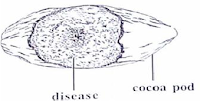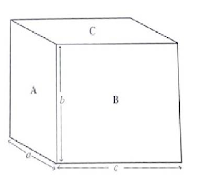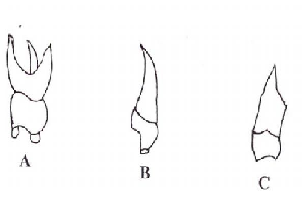BECE 2015: Chief Examiner's Report for Integrated Science
1. GENERAL COMMENTS
The standard of the paper
compared favourably with that of the previous years.
Candidates’ performance was better when compared with the
previous years.
2. SUMMARY OF CANDIDATES’ STRENGTHS
(1)
Majority of the candidates left at least two or
three lines in between their answers and this makes work very neat.
(2)
Many of the candidates wrote the question
numbers they answered on the front page in the box at the bottom.
(3)
Majority of the candidates drew their diagrams
using pencil. The diagrams were large
enough and labels provided e.g. Q3:
Emitter and Collector with the arrow well indicated.
3. SUMMARY OF CANDIDATES’ WEAKNESSES
(1)
Majority of the candidates exhibited poor
spelling of key points or terms e.g. ‘Blood pod’ instead of ‘black pod’,
‘distillation’ instead of ‘distillation’ etc.
(2)
Most of the candidates also wrote wrong facts to
some questions e.g. Q2(d) candidates wrote answers such as, clay silt and sand
which are types of soil instead of; air; water; humus etc. which are components
of soil as demanded by the question.
(3)
Majority of the candidates answered more than
one or two questions on a page. Question one was compulsory but some candidates
did not answer it.
(4)
Majority of the candidates did not add the units
for measuring the lengths, a, b, c on the diagram. Some candidates did not add the units used
for the measurement..
Many candidates did not consider the precision of the meter
rule.
4. SUGGESTED REMEDIES
(1)
As regards poor spelling of key points, it is
suggested that at least fifteen (15) minutes of each double period be used to
drill the candidates on spelling of key words/terms.
(2)
Science Teachers should teach every aspect of
the syllabus instead of teaching selected topics. Demonstration lessons could even be conducted
to highlight key words or terms.
(3)
Candidates should be informed that each new
question should be started on a fresh page.
(4)
During practical classes the candidates should
be directed to add the relevant units during measurement. The precision of the instrument used should
also be told e.g. ruler/meter rule/tape (1dp), clock (1dp), stop watch (2dp)
etc.
5. DETAILED COMMENTS
Question 1
(a)
The
diagram below is an illustration of a cocoa pod infected by a disease. Study
the diagram carefully and answer the questions that follow.
(i)
Name
the diseases illustrated on the pod.
(ii)
Mention
the causative organism of the disease.
(iii)
Describe
one symptom of the disease.
(iv)
State
one farm practice that promotes the spread of the disease. (v) Give two practices farmers could adopt
to control the disease.
(b)
The
diagram below is an illustration of a cuboid with faces A, B and C shown And
sides a, b and c indicated.
Study
the diagram carefully and answer the question that follow.
(i)
Measure
and record the length of each of the sides labelled a, b and c, in centimetres.
(ii)
Determine
the area of each of the A and B.
(iii)
 If the weight of the cuboid is 100 N,
determine the pressure exerted by the Cuboid in N/cm2 when it lies
on:
If the weight of the cuboid is 100 N,
determine the pressure exerted by the Cuboid in N/cm2 when it lies
on:
() face
A;
() face
B;
(iv)
From
your results in (iii), explain how pressure exerted by a body changes with the
area on which it lies
(c) The diagrams below are
illustrations three different types of teeth, labelled A, B and C, in humans.
Study the diagrams
carefully and answer the questions that follow.
(i)
Name
each type of teeth labelled A,B and C.
(ii)
State
one function of each type of teeth labelled A,B and C.
(iii)
State
two observable differences between the tooth labelled A and that labelled B.
(iv)
Mention
two ways of ensuring proper dental care.
(d) The diagram below is an
illustration of an experimental set- up used to separate water and salt
solution.
Study
the diagram carefully and answer the questions that follow.
(i)
Name
each of the parts labelled I,II,III and IV.
(ii)
Name
the method of separation used.
(iii)
State
one function of each of the parts labelled II and III.
(iv)
Name
three physical processes that are involved in the separation of the mixture.
Question (a)(i) to (v) was well answered by many of the
candidates.
In part (b)(i), majority of the candidates were able to
measure and obtain the correct values but they did not add the units. They wrote answers like; 2, 4, 5 instead of
2.0cm, 4.0cm, 5.0cm taking cognizance of the precision of the instrument used.
In parts (b)(ii) and (iii), many of them were able to do
the calculations but here again they were not adding the units. They wrote answers like, 2 x 4 = 8 instead of
2.0cm x 4.0cm = 8.0cm2.
In part (c)(i) majority of the candidates were able to
identify the different types of teeth labeled A, B and C.
They were able to state their functions too correctly in
part (c)(ii). Many candidates could not
however differentiate between the teeth labeled A and B.
Majority of candidates who attempted
part (d) had difficulty in labeling, I, II and III due to poor spellings e.g.
restort stand, thermometer, condenser etc.
In part (d)(iv), many candidates could not spell
distillation correctly, they spelt it like distillation (with only one ‘l’).
PART II
[60 marks]
Answer four questions only from this part.
Question 2
(a)
(i) What is technology?
(ii) State
two differences between science and technology
(b)
Draw
potassium atom and show the distribution of electrons in its shells. [K=19]
(c)
What
energy transformations take place in each of the following activities?
(i) Using a flashlight battery to produce
light in a bulb.
(ii) Using a microphone
to address a gathering.
(d)
List
three components of soil.
This question was well answered by many candidates.
In (b), majority of the candidates drew the diagram well
but they did not indicate the nucleus and electrons as demanded by the question.
Part (c)(i) was well answered by many candidates but
candidates wrote the correct answer for
(c)(ii).
Part (d) was poorly answered by many candidates. They rather provided answers for types of
soil – clay, sand, silt and loamy soil instead of components of soil – air,
water, humus, living organisms etc.
Question 3
(a)
(i) Mention
the junctions of a transitor.
(ii) Draw
the circuit symbol for n- p-n transistor.
(b)
State
one function of each of the following parts of the human circulatory system:
(i)
blood;
(ii)
blood
vessel; (iv) heart.
(c)
Classify
each of the following substances as element, compound or mixture:
(i)
air;
(ii)
brass;
(iii)
chlorine;
(iv)
gold;
(v)
water.
(d)
State
three ways of caring for farm machines.
Parts (a)(i) and (ii) were satisfactorily answered by many
candidates. Many of the candidates wrote
Base as one of the answers instead of emitter and collector only as the two
junctions.
few candidates did not indicate the arrow coming towards
the emitter and some did not draw the
circle round the circuit diagram.
In part (c), majority of the candidates obtained the
correct answers but they did not do the classification as demanded by the
tabular form like, element/compound/mixture.
Part (d) was answered by many of the candidates.
Question 4
(a)
(i) State two physical properties of water.
(ii)
Using
litmus paper, explain why water is neutral. [4
marks]
(b)
Give
one function of each of the following nutrients in plants:
(i)
nitrogen;
(ii)
potassium.
[4 marks] (c) (i) State two human activities that disrupt the carbon
cycle.
(ii)
State
two effects of the disruption of the carbon cycle on the environment.
(d) (i) What density of a body?
(ii) A body of mass 50kg has a density of 2 kg/m3.
Calculate the volume of the body.
Part (a)(i) and (ii) were attempted by
many candidates and their answers were correct except a few candidates who
could not spell – colourless and tasteless etc.
In part (b)(i) and (ii), the function (one) of nitrogen and
potassium in providing nutrients to plants was not satisfactorily answered.
Part (c)(i) and (ii) were not satisfactorily answered by
many candidates. It appears both
questions were not clearly understood by the candidates.
 In
part (d)(i), majority of the candidates defined density correctly in
words. A few also wrote the formula and
defined the key letters e.g. d = m/ where d = density, m = mass and v = volume.
In
part (d)(i), majority of the candidates defined density correctly in
words. A few also wrote the formula and
defined the key letters e.g. d = m/ where d = density, m = mass and v = volume.
The calculation on density in part (d)(ii), was
successfully done by most candidates.
Most candidates got the number correct but could not write the correct
units, 25kgm-3 instead of 25m3.
Question 5
(a)
What
is a vegetable crop?
(b)
(i) What is air pollution?
(ii)
State
two human activities that lead to air pollution.
(c)
(i) List three modes of heat transfer.
(ii)
Name
the type of medium in which each mode of heat transfer you have listed in (i)
takes place.
(d)
Give
three reasons why proteins are important in the diet of mammals.
In part (a)(i), majority of the candidates got the correct
answers to the question. A few
candidates could not spell the key words, they wrote answers like, ‘condution’,
‘convertion’ and ‘radiation’.
Part (c)(i) was well answered by majority of the
candidates.
Part (d) was poorly answered as majority could not provide
all the three reasons why protein is important to mammals.
Question 6
(a)
State
one function of each of the following parts of the human reproductive system:
(i)
penis;
(ii)
ovary;
(iii)
oviduct;
(iv) testis;
(v) uterus.
(b)
(i) What is electrical conductor?
(ii) List
two substances which are insulators.
(c)
State
three ways of maintaining soil fertility.
(d)
Write
word equation for each of the following chemical reactions:
(i)
oxygen
and hydrogen;
(ii)
nitrogen
and hydrogen; (iii) sodium and chlorine.
In part (a), the functions of each of the given
reproductive organs (i) penis (ii) ovary (iii) oviduct (iv) testes and (v)
uterus were successfully answered. A few
of the candidates produced answers like the penis is used to produce sperms and
it is also used for sexual intercourse.
Some also wrote that the ovary is to receive the sperms.
Parts (b)(i) and (ii) were correctly answered by many of
the candidates which as it is a practical question and therefore a good one.
Part (c) was also correctly answered by majority of the
candidates as it a practical question in agriculture.
Part (d) is a good question. Many of the candidates were able to write
word equation. A few of them rather
wrote the chemicals, but could not even balance them which was not the demand
of the question.
You Might Also Like:
Chief
Examiner’s Report on BECE 2017
Chief examiners report on integrated science
Chief examiner's report on BECE mathematics
Chief Examiner's Report on BECE 2017 pdf
BECE Chief Examiners Report 2017 pdf
Chief Examiners Report
BECE Chief Examiners Report
Chief Examiner's Report on WASSCE 2017 pdf
Chief Examiners Report 2017 pdf
BECE 2017 Science Questions
BECE 2015 Questions and Answers
WAEC Chief Examiners Report 2015 pdf
WAEC Chief Examiners Report 2016 pdf
Integrated science syllabus for JHS
2018 chief examiners report
Chief Examiner's Report on BECE 2018 pdf
chief examiner's report on bece 2016 pdf
BECE 2018 chief examiners report
bece chief examiners report 2018 pdf
Chief examiners report on BECE 2018
BECE Science 2017
Chief Examiner's Report on WASSCE 2016
BECE 2015 Science Questions
Chief Examiners Report 2017 BECE
BECE 2015 Science Paper 2
Chief Examiner's Report on BECE 2014
BECE 2015
Integrated Science Practical Questions and Answers
WAEC Chief Examiners Report
WAEC Chief Examiners Report 2017 pdf
Chief Examiner's Report on WASSCE 2017
Chief Examiners
Chief Examiner's Report 2017
2018 BECE Science Questions
BECE 2016 Science Questions
BECE 2017 Mathematics
Integrated Science BECE 2018 Science Questions
BECE Science Questions 2018
Chief examiners report on integrated science
Chief examiner's report on BECE mathematics
Chief Examiner's Report on BECE 2017 pdf
BECE Chief Examiners Report 2017 pdf
Chief Examiners Report
BECE Chief Examiners Report
Chief Examiner's Report on WASSCE 2017 pdf
Chief Examiners Report 2017 pdf
BECE 2017 Science Questions
BECE 2015 Questions and Answers
WAEC Chief Examiners Report 2015 pdf
WAEC Chief Examiners Report 2016 pdf
Integrated science syllabus for JHS
2018 chief examiners report
Chief Examiner's Report on BECE 2018 pdf
chief examiner's report on bece 2016 pdf
BECE 2018 chief examiners report
bece chief examiners report 2018 pdf
Chief examiners report on BECE 2018
BECE Science 2017
Chief Examiner's Report on WASSCE 2016
BECE 2015 Science Questions
Chief Examiners Report 2017 BECE
BECE 2015 Science Paper 2
Chief Examiner's Report on BECE 2014
BECE 2015
Integrated Science Practical Questions and Answers
WAEC Chief Examiners Report
WAEC Chief Examiners Report 2017 pdf
Chief Examiner's Report on WASSCE 2017
Chief Examiners
Chief Examiner's Report 2017
2018 BECE Science Questions
BECE 2016 Science Questions
BECE 2017 Mathematics
Integrated Science BECE 2018 Science Questions
BECE Science Questions 2018






.webp)








No comments: